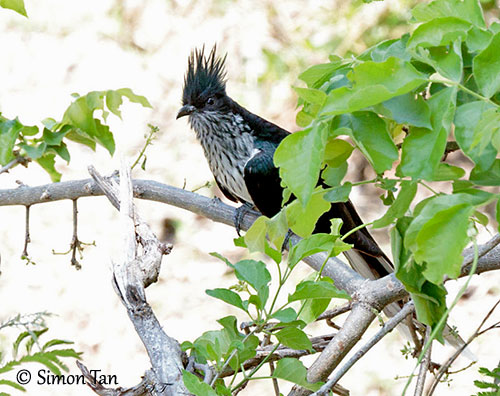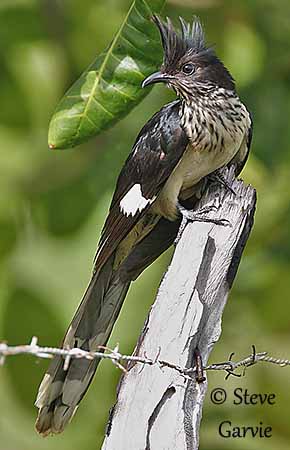
Fr: Coucou de Levaillant
Ang: Levaillant’s Cuckoo - African Striped Cuckoo - Striped Crested Cuckoo
All: Kapkuckuck
Esp: Críalo Listado
Ita: Cuculo di Levaillant
Nd: Levaillants Koekoek
Sd: Strimmig skatgök
Photographers:
Steve Garvie
RAINBIRDER Photo galleries & Flickr Rainbirder
Simon Tan
PBase Bird galleries
Text by Nicole Bouglouan
Sources:
HANDBOOK OF THE BIRDS OF THE WORLD vol 4 by Josep del Hoyo-Andrew Elliott-Jordi Sargatal - Lynx Edicions - ISBN: 8487334229
BIRDS OF THE GAMBIA AND SENEGAL by Clive Barlow and Tim Wacher – Helm Field guides – ISBN: 0713675497
BIRDS OF AFRICA SOUTH OF THE SAHARA by Ian Sinclair and Peter Ryan - Princeton University Press Princeton and Oxford - ISBN: 0691118159
Biodiversity Explorer – The Web of Life in Southern Africa
Wikipedia, the free encyclopaedia
Levaillant’s Cuckoo
Clamator levaillantii
Cuculiformes Order – Cuculidae Family
INTRODUCTION:
The Levaillant’s Cuckoo is included in the subfamily Cuculinae, in the large family Cuculidae. This subfamily gathers the Old World parasitic cuckoos. This species is a brood parasite and the female lays her eggs in the nests of some babbler species of genus Turdoides. Its main food consists of hairy caterpillar.
It is relatively common throughout its range, with currently stable population. Its name pays tribute to the French ornithologist, explorer and collector François Le Vaillant (1753-1824).

DESCRIPTION DE L’OISEAU:
Biometrics:
Length: 38-40 cm
Weight: 100-140 g
The adult has black upperparts with greenish-blue sheen. On closed wings, we can see a conspicuous white patch at primary bases. In flight, it appears like a white wingbar. On the long, graduated tail, the rectrices show broad, white terminal spots.
On the underparts, there is a characteristic bold black streaking on chin, throat and breast, contrasting with the whitish underparts. The belly may vary from whitish to creamy-white. The underwing is blackish with conspicuous white wingbar at primary bases. On the undertail, the rectrices are broadly tipped white.
The head is black on crown, nape, eye’s area and ear-coverts. The malar area is streaked black like chin and throat. There is a shaggy spiky crest made of several long black feathers.
The bill is black. The eyes are dark brown. Legs and zygodactylous feet are blue-grey.
Male and female are similar.
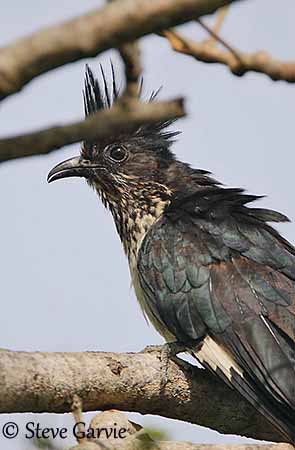
The juvenile has brown to rufous upperparts with dark brown wings. The white wing patch is more extended than on adults. The tail is mostly greyish-brown with pale rufous tips. The underparts are whitish to buffy, but chin, throat and breast are dull brown with indistinct black streaks on breast. The eyes are pale grey.
A rare melanistic form can be found in coastal E Africa, with all-black plumage, white wing patch and much reduced tail tips. The undertail-coverts may appear white sometimes.
RANGE:
The Levaillant’s Cuckoo occurs in Africa S of Sahara. It breeds from Sahel to E and S Africa. Outside the breeding season, it can be found in C Africa and costal W Africa. This species is an intra-African migrant.
HABITAT:
The Levaillant’s Cuckoo frequents well-wooded areas, savanna with Acacia, riverine forest, scrub, and can be seen in forest canopy. It is fond of well-grown gardens and frequents the few remnants of forest-thickets.
In E Africa, it occurs mainly in wet habitats and is visible up to 2100 metres of elevation.
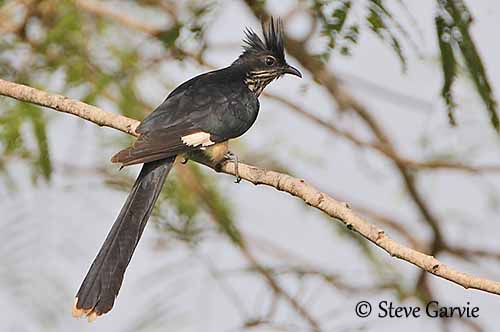
CALLS AND SONGS: SOUNDS BY XENO-CANTO
The Levaillant’s Cuckoo is extremely noisy in forested areas. It has a far-carrying, unusual voice and it is more often heard than seen.
The calls are usually heard during the rainy season and at the beginning of the dry period. It gives series of fluting “peee-u-peee-u” notes, and maintains them for some time. These calls are sometimes piercing. They are often followed by a fading chatter “atack-tacka-tacka”. We can also hear loud “klee-klee-kleeuu” followed by descending “che-che-che-che”.
The begging call of the young cuckoo often resembles the begging call of a young babbler, the host species, a harsh chattering “ker, ker, ker…”
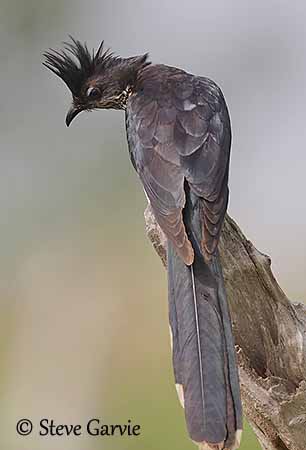
The Levaillant’s Cuckoo is an intra-African migrant. It is resident or partly migratory in equatorial regions. In W Africa, it moves into northern woodlands with the rains and into S Guinea for the dry season.
The flight is strong. The bird may spread the tail on landing, and also dives headlong into the vegetal cover. This species is often observed while crossing roads or open areas.
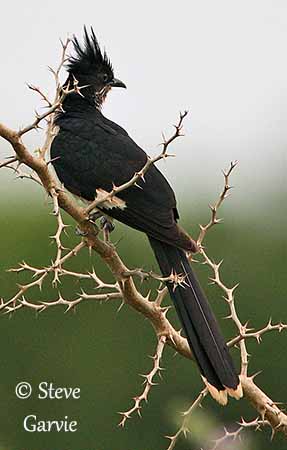
PROTECTION / THREATS / STATUS:
The Levaillant’s Cuckoo is not uncommon in its range. It is often difficult to find among the tree foliage. However, this species is common in The Gambia and Mali during the rains, and fairly common in Sierra Leone. It is rare in N Tanzania and in extreme NE of the range.
The population size is unknown but suspected to be stable. The Levaillant’s Cuckoo is currently evaluated as Least Concern.
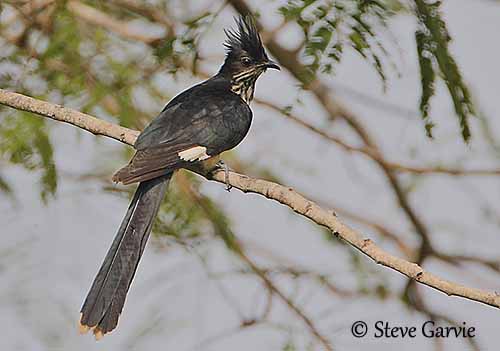
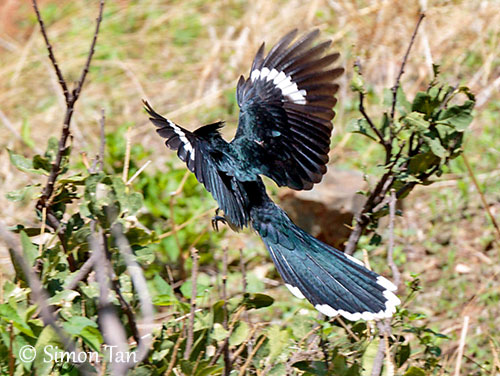
BEHAVIOUR IN THE WILD:
The Levaillant’s Cuckoo feeds primarily on hairy caterpillars (Lepidoptera larvae), but it also takes beetle larvae, grasshoppers and flying termites. Some plant matter such as berries and shoots of young trees are added to its diet.
It is mainly arboreal and forages in trees and bushes. However, it can be seen hopping on the ground while searching for food.
The Levaillant’s Cuckoo breeds during the rainy season, and this period coincides with the breeding season of the host species including several babbler of genus Turdoides.
The courtship displays of this species are poorly known, but we can suggest that the crest is raised, the long graduated tail is fanned to enhance the white terminal patches, and the wings are broadly spread to display the white wing patch.
In some cuckoo species, the male may offer a caterpillar to the female before mating. These displays are accompanied by calls from both mates.
